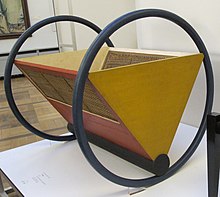Bauhaus cradle
The Bauhaus cradle , also known as the cradle according to Wassily Kandinsky , is a cross-swinging cradle designed by Peter Keler at the Bauhaus in 1922 . It was created under the influence of his master Wassily Kandinsky and is considered one of the icons of the Bauhaus.
description
The cradle is 98 cm long and 91 cm in diameter. Its elements consist of the shapes triangle, square and circle, which Wassily Kandinsky assigned to it. It has the basic colors yellow, red and blue. The cradle can be made to vibrate with the rotating blue wheel. Since the lower beam is made of solid wood, rolling over the cradle is impossible.
history
The cradle was originally part of a bed program for men, women and toddlers and was presented at the Bauhaus exhibition in 1923 in the children's room of the Am Horn model house . The cradle has been manufactured under license by the Tecta company after consultation with Peter Keler since 1975, and in a smaller version since 2018.
Web links
- Children's cradle "Bauhaus cradle"
- History of the cradle at tecta.de
- The Bauhaus cradle: Peter Keler's design classic on ndr.de from April 15, 2019
- André Kühn: Bauhaus favorites: The cradle of Peter Keler from March 23, 2018 (video)
Individual evidence
- ↑ Josef Straßer: 50 Bauhaus Icons That One Should Know , Munich, 2018
- ↑ cradle Peter Keler, 1922 at bauhaus100.de
- ↑ The cradle of the Bauhaus at Tecta
